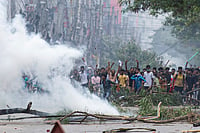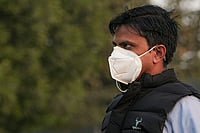Exhibit A or A, a plump eight-year-old black-and-white feline, can usually be found perched on the window to watch the birds go by, found asleep behind the television or as a willing participant in funny Insta uploads as devised by her pet parents, Hari Chakyar and Tamanna. But A also has anxiety, evident from the bald patches on her stomach and arms, and occasional mouth infection caused by licking. Moreover, she hates travelling. “She’d get a ‘panting fit’, meows and continuously,” says her dad, Hari, explaining why, despite A being absolutely terrified of loud firecrackers and dhol tashas pathaks, the family has to stay put in their second-floor flat in Mumbai’s busy Chembur area, and watch helplessly as their little one darts into the wardrobe, terrified, emerging only after the noise stops for the day.

This time around, Hari will feed A the vet-prescribed Gabapentin pill, a relaxant, to help her stay calm. He has also built a “cat cave” from a laundry basket with towels for rug and curtains, so A can crawl in and hide. “As with every year, we will shut the doors and windows, draw the curtains. It’s okay if the house becomes warm, at least she’s safe,” says the concerned parent.
For Diwali 2022, state governments across have issued complete or partial bans on the sale and production of firecrackers and hefty fines for defaulters. But certain localities remain in high decibel zones throughout the year, causing a variety of animals, and in turn their pet parents and caretakers, much trauma.
Few people, whose pets can bear long travel, chose to physically remove their pet from the distressful situation and embark on a ‘two-three vacay’ till calm has returned. Nikita Bhate says every Ganesh Chaturthi, Navratri, Eid, election rally, and cricket match that sees India win and such… leads to revelry involving loudspeakers and firecrackers on the busy Veera Desai Marg, which is so loud, the din reaches all the way up to her 17th floor flat in the vicinity, causing severe distress to her dog, Hashtag, a handsome two-year-old cocker spaniel. This Diwali the family will pack off to either a pet-friendly AirBnB in Karjat or Mulshi on the outskirts of the city.

“Otherwise, Hashtag sneezes continuously and doesn’t calm down. We try our best to keep him engaged with his favourite toys, play ball, and tug-a-war with his rope to distract him, but he has a short attention span. He loses sleep and doesn’t eat well,” The repercussions post festivities hang on for days. “He will react to any high-pitched sounds, like the doorbell ringing or a utensil falling down.” When a vacay is not possible, the family shuts the doors, and windows and turns on the air conditioning “as the hum of the AC as it reduces the external noise”, says Bhate.
Canine behaviourist, Calvin Godinho, through his Instagram account @dogknowwhy organised an IG live session with Dr Akhil of Progressive Pet Clinic, to placate pet parents and equip them better for Diwali 2022. The first step is to gauge whether the fear in your dog is momentary or deep seated, do this, advises Godinho, by putting your dog through the low-level (occasional plaything) and high-level (favourite plaything) toy test. During the high decibel hours, test the dog with these toys. If the dog plays with the low-level toy, the task to desensitise the dog to high decibel sounds is easier than you think. If the dog refuses to engage with even a high-level toy, then the stress is significant.
Salivating, whining, panting out of context (as in not after a run, spotting food, or bout of excitement), pacing up and down, crouching with the head hanging low and tail slightly tucked, trembling all over, peeing/excreting out of turn, trying to hide or escape, zooming room to room, sudden aggressive behaviour, etc.,… all these actions, he says, are physical manifestations of stress.
After identifying the level of fear, then look at remedy using the control and management approach of behaviour training. Try desensitising – exposing the dog to whatever stimuli it’s afraid of in small/mild doses, eventually building it up to a level it no longer feels fear. Don’t punish the dog if it's acting out of turn as this is temporary behaviour. Don’t force the dog to confront its fear as it may freeze or even run towards the reason for its fear, in this case, firecrackers, and injure itself in the process. Your canine views you as a role model so try and remain a picture of calm in the face of loud sounds.
Godinho stresses on advance preparation. Prepone daily walk timings at least 10 days before the festival so that your dog is back indoors before the loud revelry begins. This way, it has enough time to adapt to its new diet, sleep, and potty training schedules. Avail of technology solutions such as the Thundershirt anxiety dog jacket or pheromone collar and diffuser.
Post the event, once your dog has sort of calmed down, try and activate its scent and taste. Use a new scented candle or an essential oil around the house and try massage techniques such as tellington TTouch therapy (check YouTube videos).
Pay heed to other pet species besides dogs and cats, urges exotic pet expert, Soham Mukerjee. Several exotic species, including all pet birds, become extremely stressed due to the high noise levels and vibrations, which can even prove fatal. “Exotic pets are descended from wild counterparts, and they are biologically very sensitive to sounds. They use their hearing to protect themselves from predators. Their hearing is sensitive enough to pick up on even the smallest sounds in their surroundings. So, during these high decibel celebrations, birds and reptiles experience similar, if not greater, stress than dogs and cats,” Mukerjee explains.
Such abrupt changes can lead to abnormal behaviours, as animals are sensitive to their everyday environment. “One might notice severe panic in animals, especially small and young ones who have no context for such experiences.” During such festivities, “rescue operations” escalate for both pets and wild animals, along with injuries, illnesses, and other ailments. In such cases, it’s better to medicate the animal. “A medically induced calm animal will fare better than a scared one, as stress can weaken the immune system, leading to other health problems,” says Mukerjee.
Plus the noise and smoke result in a “toxic cocktail”. “Mortality of small birds, particularly those of young chicks, is not uncommon. In the case of forest fires, a majority of animals attempt to move away from the source, but urban animals do not have that option, as firecrackers explode all over the city, causing widespread panic due to the loud noises and high levels of smoke,” he adds.
In the case of strays, caretakers can create temporary shelters at their usual hiding spaces, so they feel safer than the outside “war zone”, advises Mukerjee.


























